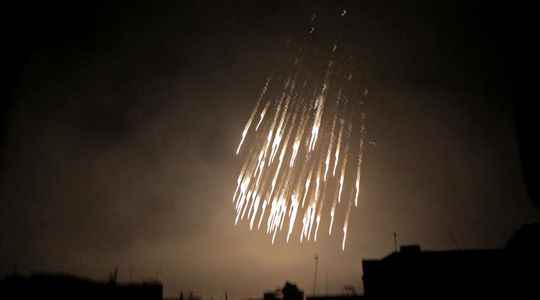Ukrainian President Volodymyr Zelensky on Thursday (March 24) accused Russia of using “phosphorus bombs” in Ukraine. “Adults have been killed and children have been killed again,” said the leader in a new video message published on his Telegram account for the attention of the Heads of State and Government of the Atlantic Alliance, meeting in extraordinary summit in Brussels.
Volodymyr Zelensky refers to a strike on the town of Roubjiné, near Lugansk, in the east of the country, which took place on Thursday, and which killed four people including two children. According to the governor of the region, Serguiï Gaïdaï, Russia would have launched phosphorus bombs on its territory. He fears, thus, that the final assessment of the attack will be even heavier than that announced.
This is not the first time that the alert has been given during this conflict. Similar weapons were also reportedly used, still near Lugansk, in Popasna, from March 13. No later than Wednesday, March 23, near kyiv, in Irpin, Mayor Oleksandr Markouchine also confided in having observed the use of white phosphorus as war material.
Not prohibited…
What are we dealing with? White phosphorus is a chemical. It is employed in three different ways on the battlefield. First for the light it generates when it ignites on contact with the air. Then, for its incendiary properties. Phosphorus generates thick smoke that can be used as smoke bombs. Finally, in contact with soldiers and civilians, it finally causes significant burns and can lead to death.
However, bombs using this phosphorus are not considered chemical weapons. They are therefore not prohibited from use on the battlefield. Russia, in Chechnya as well as in Syria, but also the United States, in Iraq, have already used this white phosphorus on several occasions. “The military uses this if they attack a city that’s defended by people in holes or fortifications inside the city. They smoke those people out, and then hit them with high explosives. That’s what the United States did in Fallujah, Iraq,” cites weapons specialist Mark Hiznay of the NGO Human Rights Watch (HRW).
…except against civilians
But the use of these bombs aimed directly at “concentrations of civilians” is prohibited by the Protocol III of the Geneva Convention, governing the use of incendiary weapons, including those containing white phosphorus. This is what the Ukrainian authorities intend to denounce.
Why does Russia allow it anyway? The current stalemate of his army and the frustration that this situation generates could explain it. Vladimir Putin’s army has been bombarding Mariupol and its inhabitants relentlessly for several weeks. Several of these strikes are the subject of investigations, like the one that affected a maternity hospital. US President Joe Biden, as well as Volodymyr Zelensky, also fear that Russia will end up using chemical and biological weapons to achieve its ends. Phosphorus could then only be a weapon like any other to bend Ukraine.
But according to HRW, Russia would also benefit from a gray area in the current texts. Phosphorus bombs are said to be “essentially designed” to create a smoke screen to conceal military operations. The incendiary use here would only be fortuitous. These bombs would then not really fall within the definition of incendiary weapons as mentioned in Protocol III of the Geneva Convention. A defense that could be put forward by Russia, if it is accused of war crimes for their use in this conflict.
